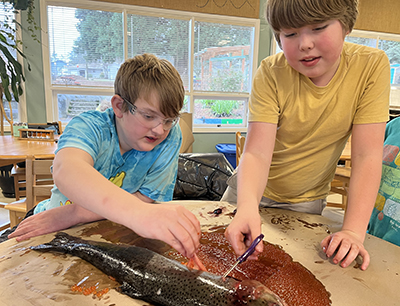By Melissa Wagoner
When Alyssa Burge discovered an empty aquarium labeled “ODFW Salmon Release,” at the Community Roots School in Silverton, where she had just taken on the role of Garden Specialist in 2019, she knew she had to learn more.
“So, I tracked it down on the internet,” she said, recalling her first introduction to the Oregon Department of Fish and Wildlife’s Salmon and Trout Enhancement Program (STEP), which has delivered salmon and trout eggs to classrooms and other educational environments throughout the state since 1981.
“The more people interact with the fish the more people care about them,” Reed Fischer, an assistant district biologist with ODFW, said of the impetus for the program, which is less about restocking the rivers with fish – only a small portion of the estimated 15,000 eggs he delivers to Willamette Valley classrooms will survive to reproduce – and more about opening hearts and minds.
“If you interact with them on a day-to-day basis it’s going to be something you’ll love,” Fischer said, describing the benefits of the STEP program and of ODFW’s many fishing programs as well.
“If it becomes an area they care about, people will protect it.”
It’s a belief Burge – whose goal is to introduce her students to as many aspects of the natural environment as possible – also holds. She integrated STEP into her curriculum, covering everything from habitat, ecology, food chains and food webs, to water temperature, erosion and climate change.
“We talk about the dangers the fish will face – dams, overfishing and pollution – and we do an invertebrate study,” Burge said.
“Then this year we did a lot of cultural significance with tribal history. We did our first salmon tasting and all the kids got to taste wind dried salmon from a member of the Warm Springs Reservation. We talked about the significance salmon has in the food chain and why it’s such a cornerstone species.”
All the while the kids spent time outside, observing the salmon – first as eggs, then as newly hatched alevin – recording the water temperature and adjusting the environment of the tank as needed.

“With the kindergarteners, we move around the garden like salmon and then we watch them,” Burge described. “Then the upper levels, they do all of the calculations and present it to the younger classes.”
Those calculations include the estimated hatching dates, which the students can somewhat control by adjusting the temperature of the water. But they must be careful because the eggs are delicate, and the slightest miscalculation can cause them to die.
“But even in death there’s a lesson,” Fischer pointed out. “We had one student who put on hand sanitizer and then reached into the tank and polluted the tank. That was a lesson about pollution. Sometimes I get phone calls from people who are in tears because some of their eggs died.
The expectation is that all of them will survive. But in the wild that doesn’t happen.”
And even if all of the eggs do survive, releasing them into a nearby stream still comes with some risk.
“When they’re being released they’re at a really vulnerable stage of life,” Fischer said. “And in a lot of the areas the streams the schools have to release into are difficult to survive in. But we’re limited by where we can actually get these students out on a creek. It’s kids’ education first and fish second.”
Fortunately, Silver Creek is a relatively hospitable habitat, even boasting a Salmon Watch site – where middle school and high school students can observe spawning salmon in the fall, learning more about their life cycle from a member of the Marion County Soil and Water Conservation District.
“All the salmon come back in a four day window,” Burge said, noting that her sixth grade students will take part in that program this coming fall.
There is also an opportunity to dissect a spawned out salmon – something Burge’s students have already experienced thanks to Fischer.
“He brought in a doctoral veterinarian student who went through all the anatomy of how [salmon] function in the wild,” Burge recalled.
“Some teachers definitely go the extra mile to bring in these programs,” Fischer said, adding that, while it is not uncommon for teachers to add to the suggested curriculum ODFW provides, the amount of bonus lessons Burge provides is rare.
Perhaps the most important thing the students learn is to be curious about the world around them.
“If we could just get kids down to look at these salmon it’s a game changer,” Fischer said.
“I’ve heard from coworkers that they were in this program as kids and that’s what got them into wildlife. But the varying degrees of teachers’ programs can make or break the program… Alyssa’s been great. And more and more teachers are adopting that.”